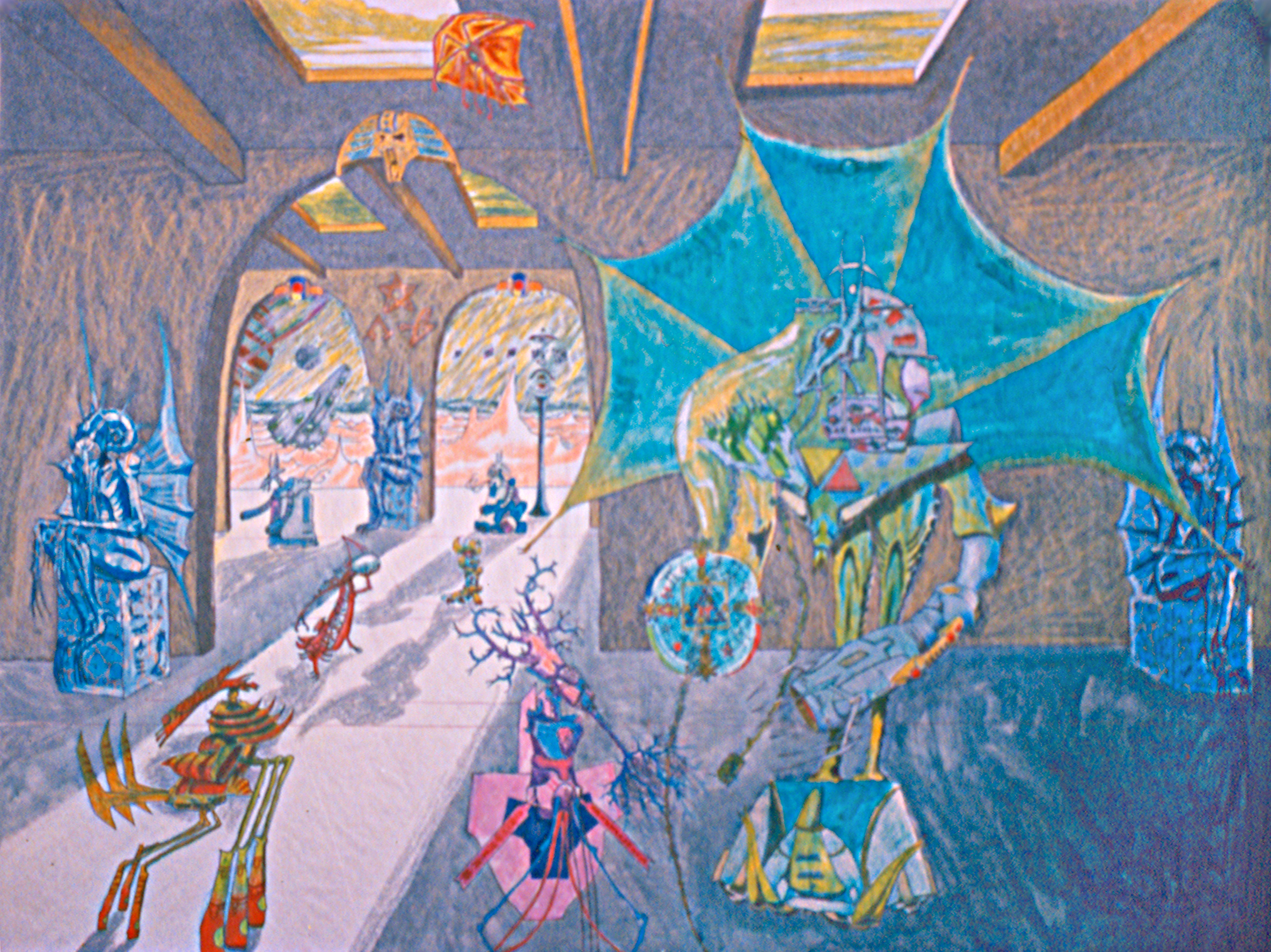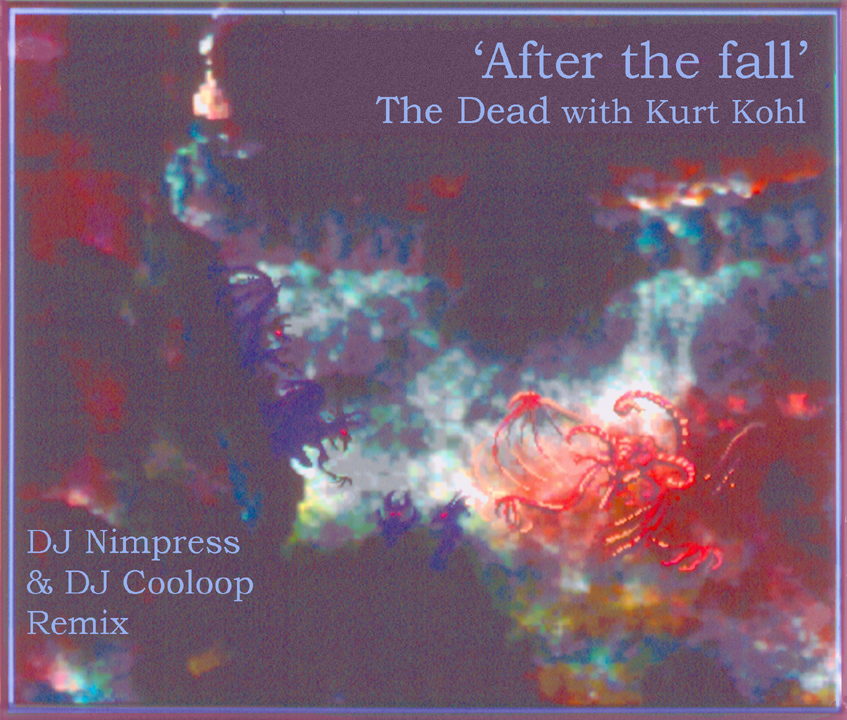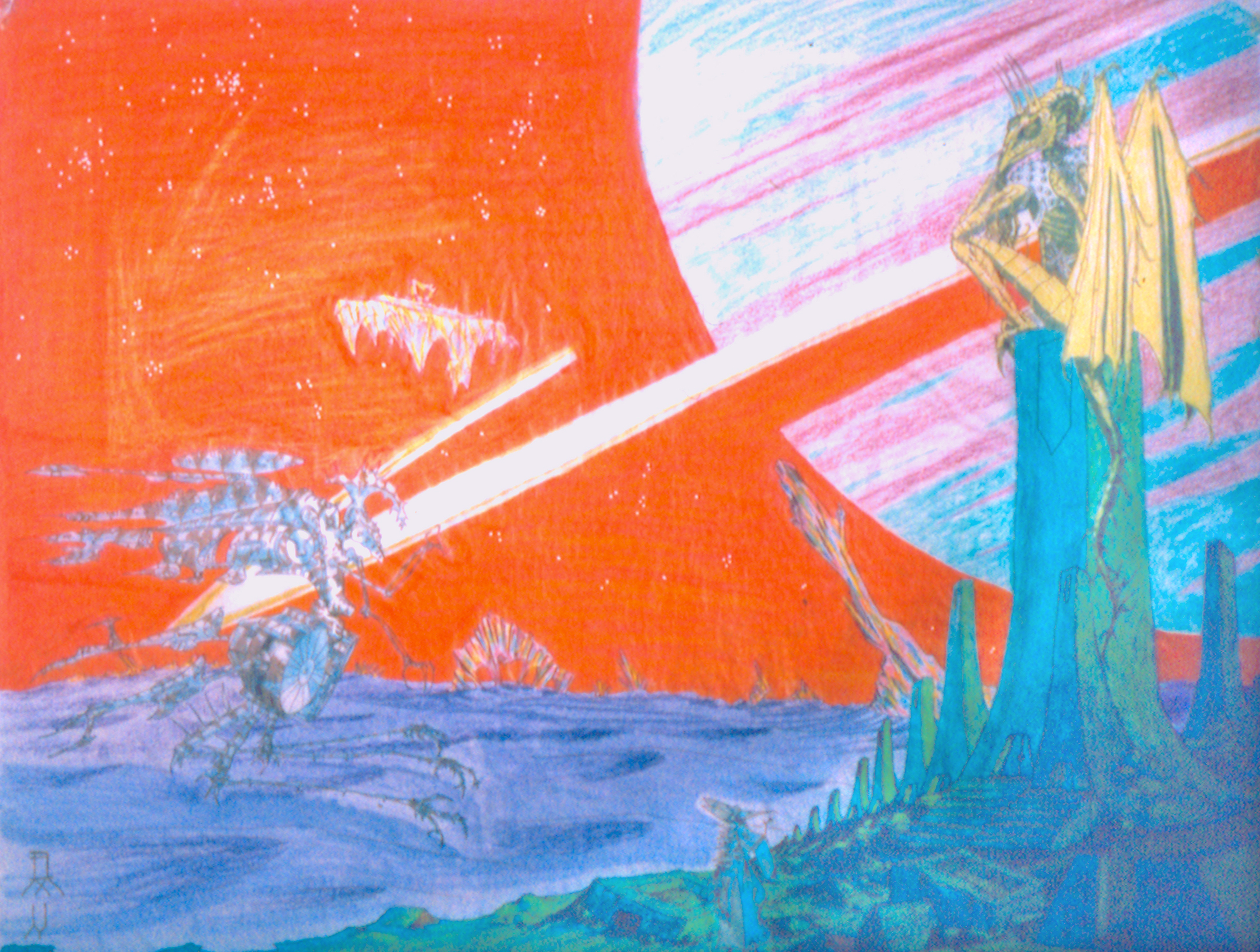 |
An Outsider Artist From Punk to Painter
By Special Arts
Writer Tonya Nordman
I had recently the good luck to find an address for an artist who has
been very difficult to locate. I was able to interview him, and
critique many paintings and prints. Mr. Kurt Kohl has been homeless
for over half his life and yet has produced a large collection of
works. Mr. Kohl has paintings, drawings, prints, renderings,
watercolors, charcoals, pastels, multi-media and miniature metal
sculptures; all created by his own hand. The works are thought
provoking, somewhat disturbing landscapes of meta-symbolic figures and
highly archetypal environments. Mr. Kurt Kohl also known as 'Curtis'
has works from 1964 to 2005: the main themes are at once Dali and Max
Ernst combined with Yves Tangeuy or Robert Matta. He seems to have
started with figures at the technical level of a surrealist master as
far back as four years old. The works begin with a Childs'
interpretation of an intricate dream landscape, an internalized
symbol-system produced by a very creative, yet mentally disturbed and
very young mind.
Curtis Kohl was born in 1960 in
Detroit; the only white family on Twelfth Street and Grand Blvd. His
family was abusive and negligent, the parents having drug and alcohol
problems. Severe mental problems and degenerative nerve disease was
never treated in the boy and he was beaten by his father and
neighborhood gangs on several times. The subsequent skull fractures
contributed to his learning difficulties and he was placed in special
education classes from the third grade until ninth grade when he left home. Many of the early works still exist as Mr. Kohl would keep
drawings on his person or hidden in cardboard boxes behind a local
tire shop. Several sculptures made when he was eleven were kept in
good condition for many years. The itinerary of his images are all
works resembling inherited memory; atavistic beings which cannot be
classified in terms of an exact symbol or recognizable being or
animal. The works are not the usual 'brut' version of outsider art;
the sculptures and images are more intelligent, more thought-out with
a layered iconographic content that rivals Duchamp and Miro.
left home. Many of the early works still exist as Mr. Kohl would keep
drawings on his person or hidden in cardboard boxes behind a local
tire shop. Several sculptures made when he was eleven were kept in
good condition for many years. The itinerary of his images are all
works resembling inherited memory; atavistic beings which cannot be
classified in terms of an exact symbol or recognizable being or
animal. The works are not the usual 'brut' version of outsider art;
the sculptures and images are more intelligent, more thought-out with
a layered iconographic content that rivals Duchamp and Miro.
Cesare Lomboros' book 'The Art of the
Insane', talks of the rare tendency towards atavism in the detailed
renderings created by certain mentally ill persons. Mr. Curtis Kohl
creates such paintings: multi-media pieces depicting a world of
futuristic, archetypal beings involved in ineffable activities or
captured in living landscapes that resemble a snapshot from another
planet, taken by a man who has returned from such a place.
Curtis Kohl ran away from home at
fifteen after a very bad assault by his father and mother; he went to
live with the only other family he knew, a group of junkies. The
arrangement didn't last and he was back on the streets. Curtis had
started to learn to trust people with stacks of his art, and even
though few people would let him live in their homes, sometimes they
would store his art for him. He had met a group of musicians who
introduced him to narcotics and speed; which worsened his existing
mental condition. He had been manipulated and had his welfare checks
taken from him by a member of this group. Curtis then was threatened
and forced to leave. Living on the streets again, he was picked up by
police and placed in a psychiatric facility for observation. Curtis
says he was glad to eat and be warm, but there was no chance of
getting paper, pens or pencils and all of the images that he had ideas
for, were lost. He was unable to draw any of the visions from
lockdown. There were paintings, however, hidden away on the outside.
This was the first in a series of
problems that led him to be homeless again. He had hung out in front
of 'Bookies' a punk bar in 1975. He had met a group of punks and was
allowed to stay at a skinheads' house. Curtis was a punk rocker since
1974, so he felt welcome and he immediately set up a small table: a
place to create art in the small, filthy house. Curtis Kohl created
many works of art and started to display art in the same coffee shops
and punk stores where he hung out. He had made punk band flyers and
joined a hardcore band: organizing outdoor punk shows in Royal Oak.
Many of the stores made money from Curtis' artwork or jewelry; he was
rarely paid. Royal Oak benefited especially from Curtis Kohls'
influence and artistic presence in 1979-1982.
Mr. Kohl kept trying to create art and
started painting T-shirts and putting on fashion shows with no budget:
punk friends as models and using isolate, unusual factory locations to
create an artistic backdrop for his bizarre dark clothes. Even when
homeless, he would stay at a persons basement long enough to create a
variety of geometric tops and shirts covered with strange futuristic
alien paintings for a show planned for the following weekend. These
early fashion shows were broadcast on local TV and early cable TV: The
Free Press, The Detroit News would follow with articles on 'Kurt'.
By 1981, Mr.Kohl had many art shows,
fashion shows and related events. Sales of art/clothes were seemingly
insufficient to get an apartment or house; so he was still homeless.
'Kurt Kohl' T-shirts were the hit of
the 1981 New York Boutique show, but the distributor and a local punk
store owner stole the profits and defrauded Kurt. The same punk store
owner conspired with a local biker jewelry maker to mass produce Mr.
Kohls designs in silver: the designs are still for sale in punk stores
in Chicago and Mr. Kohl still receives no percentage for his work.
Depression set in and Curtis was soon back in a rehabilitative mental
health facility. 36 days later, Mr.Kohl was released: he had walked to
the friends house who was currently storing his art, designs, and
custom t-shirts. The friends house had flooded and many paintings were
destroyed, many t-shirts had mold on them and could not be sold. A
painting that hung at a local gallery had also been stolen. Kurt spent
many years being homeless; living in basements or sleeping in cars,
being screamed at by the vehicles' owners after seeing a death punk in
their car asleep. He would be sitting in coffee shops day after day
drawing, or trying to get his works sold without being ripped-off by
stores. Curtis says he also walked round a lot back then; through
crack neighborhoods and old abandoned buildings, and rail yards.
Curtis Kohl made contacts amongst the
1984 punk scene that resulted in a venture; a store in a mall, paid
for and sponsored by a downtown Detroit hall owner. Curtis gathered up
t-shirts from churches and goodwill and painted them: but he had also
made arrangements for a shipment of 1,500 t-shirts to be sent from
Hong Kong. A local S&M personality said that she would help to open a
store and pay for materials if the club owner buys the building and
purchases a industrial seeing machine.
Curtis leased a building in 1984 and
was expecting to have a company running very soon thanks to the
investors: the club owner and the S&M practitioner. In august of 1984,
Curtis says, everything screwed up: people pulled out of clothing
deals, t-shirt palettes were tied up in a port in New York and the
building he rented was closed down by police because of the punk bands
that hung out there and practiced and played. The big mall deal failed and all the partners changed their
minds; even though there were recent cable coverage of art shows that
Kurt had accomplished.
played. The big mall deal failed and all the partners changed their
minds; even though there were recent cable coverage of art shows that
Kurt had accomplished.
Kurt Kohl had saved most of the
paintings and jewelry created in the building, he called, the
'Asylum': this was a private joke, very few people knew that Curtis
had been in and out of mental health care system since 1976. Homeless
again, he was arrested for loitering, put into lockdown after the
Detroit police had found a history of mental illness, and released 3
weeks later. In 1985 Mr. Kohl went to LA to try to secure a record
deal with a back up contact for jewelry manufacture: neither business
deal was successful and he wound up homeless in Los Angeles. Curtis
says he was homeless in L.A. for under a year; he had stayed with a
street-gang of Hispanic crank heads. In 1986, Mr.Kohl returned to
Detroit and was able to do a few art shows and sell half-dozens of
t-shirts to stores.
Curtis rented a house with other
death-punks in 1987 and produced several tapes and four art shows.
Channel 2 of Detroit interviewed him about being a 'punk artist', and
the free Press did another article on him. Curtis was able to meet a
representative for Brookes Brothers leather jackets, but the rep
wouldn't commit to a short run of 'Kurt Kohl Leathers'. Curtis says
the rep wanted 1,000 units or there was no deal. Curtis was seeing a
Mental health care worker at the time; but a long depression set in.
Drug use at the punk house increased and the local punk scene suffered
as many punks were drawn deep into crack or speed. The punks who had
families or other houses had moved out, and Mr. Kohl was homeless
again. There was a two week observation for Curtis in 1989, when he
was arrested having suffered a severe psychiatric episode. Curtis Kohl
left Detroit for Lansing, and stayed with college kids who enjoyed the
novelty of having a 'real punk' stay at their house or dorm.
Mr. Kohl applied at Lansing community
college and got enough student loans to get an apartment. He created
very intricate, bizarre digital videos and computer art in school;
surrealist, strongly thematic and dark and alien-esque.. Even though
Curtis was a 4.0 GPA and accepted to Phi Theta Kappa, Teachers and
instructors were unwilling to assign internships to him. His professor
wrote a letter of recommendation stating, 'he was extremely strange'.
There were no jobs for him, even though other students always asked
him for help in the 3D imaging computer department.
Mr. Kohl was on 'The Deans List' and
won a 'Michigan Excellence in Education Award'; the award was given to
him in the late evening, when he was in the computer lab alone. The
instructor simply handed him the award. Curtis discovered months
later, that the only other student to achieve that ward, was given a
big ceremony with many people: the staff, teachers and professors
attending. Mr. Kohl was very upset with that college and left Lansing
to go to a different school: an art school.
In 1991 Curtis Kohl got into SAIC, a
prestigious art school. Things got of to a sour note when the SAIC
Dean said to Curtis that 'there were no grants, scholarships, or merit
awards'. This was an outright lie.
Curtis took out more student loans and
attempted to take classes at SAIC. Curtis found the School of the Art
Institute of Chicago to be very hostile to him as a disabled person,
and completely unwilling to acknowledge basic 'Americans with
Disability Act' guidelines. Instructors would outright lie about the
use and availability of computers or other equipment. He was not
accepted to exhibit works at either campus gallery: he was verbally
harassed by instructors and threatened by professors. Curtis Kohl
Exhibited three shows in the lobby and galleria of the Cermak Road
-'Spice Factory', an artist co-op in Chicago. Curtis was unable to get into any professional art shows, but
was able to do the computer art backgrounds for "Strawberry Planet", a
children's show on Chicago cable. He also produced a show of his
alien-surreal landscapes; it was aired 6 times on Chicago cable.
Curtis did the purchase and installation of a pre-press computer
terminal for a small adult-entertainment paper. In 1995, he moved back
to Detroit and put many paintings in storage with the larger
collection. His degenerative nerve disease had progressed, and had
limited his walking and use of his hands, by the destruction of muscle
mass in his body.
Chicago. Curtis was unable to get into any professional art shows, but
was able to do the computer art backgrounds for "Strawberry Planet", a
children's show on Chicago cable. He also produced a show of his
alien-surreal landscapes; it was aired 6 times on Chicago cable.
Curtis did the purchase and installation of a pre-press computer
terminal for a small adult-entertainment paper. In 1995, he moved back
to Detroit and put many paintings in storage with the larger
collection. His degenerative nerve disease had progressed, and had
limited his walking and use of his hands, by the destruction of muscle
mass in his body.
Curtis Kohl joined Very Special Arts
and had 4 paintings selected to tour all of Michigan's museums. Curtis
was featured in RawVision #28 with a photo of his art and a small
write-up. In 1999 Mr. Kohl moved to rural area outside Flint,
Michigan. He uses computers at libraries, adult learning centers and
campuses, although he will not enroll or take classes. He has a
trailer in very bad shape: he rarely has electricity, water or heat
all at once. He was selected for the POLK art show 2002. Mr. Kohl has
a keen intelligence and an awareness of art and design that is
profound. He has a collection of over 17,000 drawings, paintings,
prints and images. He has created 75 hours of dark and fantastic
computer animation and interactive computer art. He has worked with a
rehabilitative nurse to produce 27 cds of digital electronic music: He
had radio airplay in America three times, and in Europe twice. He is
devoted to his art: he continues to produce art and digital
interactive pieces, even with mental illness and chronic pain from
nerve disease.
"The images are almost exactly as I see
them in my mind now; I have arrived at a confident level of faithfully
reproducing the complex vision of the mind-space beings in my work, it
is as I have seen them. When you asked for the early drawings from
when I was kid, I didn't know what to think or expect... But now I see
that the figures in my childhood drawings are the same as my subject
matter currently, only I am a better artist technically now!".
I feel as though the arcane vision that
Mr. Kohl carries, has brought him safely through a turbulent and
violent circuit. He holds the prize, The beau ideal: the Ideal
of Perfection, he has perfected his vision.
Article for publication
Tonya Nordman
|


